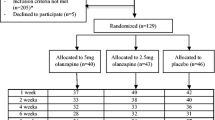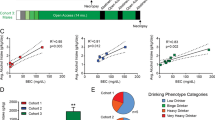Abstract
A considerable number of animal studies on the effects of dopaminergic agents on alcohol intake behavior have been performed. Acute alcohol administration in rats induces dopamine release in the caudate nucleus and in the nucleus accumbens, an effect related among others to reinforcement. It has been repeatedly suggested that D1 and D2 receptor activation mediates reward. As alcohol consumption and dopaminergic transmission seem to have a close relationship, all kinds of dopaminergic agents may be regarded as putative therapeutics for preventing relapse. In a prospective European double-blind multicenter clinical trial, comparing the D1, D2, D3 antagonist flupenthixol and placebo in 281 chronic alcohol-dependent patients (27.4% women), the application of the Lesch typology made an outcome differentiation possible. It could be shown in which patients flupenthixol administration was followed by a significantly higher relapse rate and in which patient groups no differences were found when compared to placebo.
Similar content being viewed by others
References
Acquas E, Carboni E, Leone P, Di Chiara G. SCH 23390 blocks drug-conditioned place-preference and place-aversion: Anhedonia (lack of reward) or apathy (lack of motivation) after dopamine receptor blockade? Psychopharmacology 99:151–155;1989.
Addolorato G, Castelli E, Stefanini GF, Casella G, Caputo F, Marsigli L, Bernardi M, Gasbarrini G and GHB Study Group. An open multicentric study evaluating 4-hydroxybutyric acid sodium salt in the medium-term treatment of 179 alcohol dependent subjects. Alcohol Alcohol 31:341–345;1996.
Addolorato G, Cibin M, Caprista E, Beghe F, Gessa GL, Stefanini GF, Gasbarrini G. Maintaining abstinence from alcohol with gamma-hydroxybutyric acid. Lancet 351:38;1998.
Babor TF. Types of alcoholics: Concurrent and predicitve validity of some common classification schemes. Br J Addict 87:1415–1431;1992.
Battaglia G, Titeler M. (3H)N-propylapomorphine and (3H)spiperone binding in brain indicate two states of the D2-dopamine receptor. Eur J Pharmacol 81:493–498;1982.
Bauché F, Bourdeaux-Jaubert AM, Giudicelli Y, Nordmann R. Ethanol alters the adenosine receptor-Ni-mediated adenylate cyclase inhibitory response in rat brain cortex in vitro. FEBS Lett 219:296–300;1987.
Becker HC, Diaz-Granados JL, Weathersby RT. Repeated ethanol withdrawal experience increases the severity and duration of subsequent withdrawal seizures in mice. Alcohol 14:319–326;1997.
Borg V, Weinholdt T. Bromocriptine in the treatment of the alcohol withdrawal syndrome. Acta Psychiatr Scand 65:101–111;1982.
Borg V. Bromocriptine in the prevention of alcohol abuse. Acta Psychiatr Scand 68:224–227;1983.
Bozarth MA. The mesolimbic dopamine as a model reward system. In: Willner P, Scheel-Kruger J, eds. The Mesolimbic Dopamine System: From Motivation to Action. New York, Wiley; 1991.
Cloninger CR. A systematic method for clinical description and classification of personality variants. Arch Gen Psychiatry 44:573–588;1987.
Darden JH, Hunt WA. Reduction of striatal dopamine release during an ethanol withdrawal syndrome. J Neurochem 29:1143–1145;1977.
Di Bello MG, Gambassi F, Mugnai L, Masini E, Mannaioni PF. Gamma-hydroxybutyric acid induced suppression and prevention of alcohol withdrawal syndrome and relief of craving in alcohol dependent patients. Alcologia 7:9–16;1995.
Di Chiara G, Imperato A. Drugs abused by humans preferentially increase synaptic dopamine concentrations in the mesolimbic system of freely moving rats. Proc Natl Acad Sci USA 85:5274–5278;1988.
Di Ciano P, Blaha CD, Phillips AG. Conditioned increases in motor activity and dopamine concentrations in the nucleus accumbens of the rat following repeated administration of cocaine ord-amphetamine. Soc Neurosci Abstr 21:2103;1995.
Dongier M, Vachon L, Schwartz G. Bromocriptine in the treatment of alcohol dependence. Alcohol Clin Exp Res 15:970–977;1991.
Farren CK, Clare AW, Ziedonis D, Hammeedi FA, Dinan TG. Evidence for reduced dopamine D2 receptor sensitivity in post-withdrawal alcoholics. Alcohol Clin Exp Res 19:1520–1524;1995.
Fontana DJ, Post RM, Pert A. Conditioned increases in mesolimbic dopamine overflow by stimuli associated with cocaine. Brain Res 629:31–39;1993.
Gallimberti L, Ferri M, Ferrara SD, Fadda F, Gessa GL. Gamma-hydroxybutyric acid in the treatment of alcohol dependence: A double-blind study. Alcohol Clin Exp Res 16:673–676;1992.
Gessa GL, Vargiu L, Crabai F, Boero GC, Caboni F, Camba R. Selective increase of brain dopamine induced by gamma-hydroxybutyrate. Life Sci 5:1921–1930;1966.
Gessa GL. Gamma-hydroxybutyric acid (GHB) for treatment of alcohol dependence. Alcohol Alcohol 28:214;1993.
Gopinathan G, Horowski R, Suchy IH. Lisuride pharmacology and treatment of Parkinsons's disease. In: Calne DB, ed. Drugs for Treatment of Parkinson's Disease. Berlin, Springer, 471–513;1989.
Guardia J, Catafau A, Batlle F, Martin JC, Segura L, Gonzalvo B, Prat G, Carrio I, Casas M. Striatal dopaminergic D2 receptor density measured by (123I) iodobenzamide SPECT in the prediction of treatment outcome of alcohol-dependent patients. Am J Psychiatry 157:127–129;2000.
Heinz A, Dettling M, Kuhn S, Dufeu P, Gräf KJ, Kürten I, Rommelspacher H, Schmidt IG. Blunted growth hormone response is associated with early relapse in alcohol-dependent patients. Alcohol Clin Exp Res 19:62–65;1995.
Heinz A, Lichtenberg-Kraag B, Sällström Baum S, Gräf K, Krüger F, Dettling M, Rommelspacher H. Evidence for prolonged recovery of dopaminergic transmission after detoxification in alcoholics with poor treatment outcome. J Neural Transm (Gen Sect) 102:149–157;1995.
Heinz A, Rommelspacher H, Gräf KJ, Kürten I, Otto M, Baumgartner A. The hypothalamic-pituitary-gonadal axis, prolactin and cortisol in alcoholics during withdrawal and after three weeks of abstinence and in healthy controls. Psychiatr Res 56:81–95;1995.
Heyser CJ, Schulteis G, Durbin P, Koob GF. Chronic acamprosate decreases derpviation-induced ethanol self-administration in rats (abstract). RSA/ISBRA Sci Meet, Lahaina, Hawaii, 1996.
Heyser CJ, Schulteis G, Durbin P, Koob GF. Increased ethanol self administration after a period of imposed ethanol deprivation in rats trained in limited access paradigm. Alcohol Clin Exp Res 21:784–791;1997.
Hoffman PL, Tabakoff B. Ethanol and guanine nucleotide binding proteins: A selective interaction. FASEB J 4:2612–2622;1990.
Koob GF, Le Moal M. Drug abuse: Hedonic homeostatic dysregulation. Science 278:52–58;1997.
Koob GF, Roberts AJ, Schulteis G, Parsons LH, Heyser ChJ, Hyytiä P, Merlo-Pich E, Weiss F. Neurocircuitry targets in ethanol reward and dependence. Alcohol Clin Exp Res 22:3–9;1998.
Lavicky J, Dunn AJ. Corticotropin releasing factor stimulates catecholamine release in hypothalamus and prefrontal cortex in freely moving rats as assessed by microdialysis. J Neurochem 60:602–612;1993.
Leone P, Di Chiara G. Blockade of D-1 receptors by SCH 23390 antagonizes morphine and amphetamine-induced place preference conditioning. Eur J Pharmacol 135:251–254;1987.
Lesch OM, Walter H, Rommelspacher H. Alcohol abuse and alcohol dependence. In: Rommelspacher H, Schuckit M, eds. Baillière's Clinical Psychiatry. Chapter 3: Drugs of abuse, 1996.
Lesch OM, Walter H. Subtypes of alcoholism and their role in therapy. Alcohol Alcohol 31:63–67;1996.
Limbird LA. Activation and attenuation of adenylate cyclase: The role of GTP binding proteins as macromolecular messengers in receptor cyclase coupling. Biochem J 195:1–13;1981.
May T, Wolf U, Wolffgramm J. Striatal dopamine receptors and adenylyl cyclase activity in a rat model of alcohol addiction: Effects of ethanol and lisuride treatment. J Pharmacol Exp Ther 275:1195–1203;1995.
McBride WJ, Bodard B, Lumeng L, Li T-K. Association between low contents of dopamine and serotonin in the nucleus accumbens and high alcohol preference. Alcohol Clin Exp Res 19:1420–1422;1995.
Mozaroti SL. VTA dopamine neuron activity distinguishes alcohol-preferring P rats from Wistar rats. Alcohol Clin Exp Res 22:854–857;1998.
Munemura M, Agui T, Sibley DR. Chronic estrogen treatment promotes a functional uncoupling of the D2 dopamine receptor in rat anterior pituitary gland. Endocrinol 124:346–355;1989.
Naranjo CA, Dongier M, Bremner KE. Long-acting injectable bromocriptine does not reduce relapse in alcoholics. Addiction 928:969–978;1997.
Nimmerrichter A, Walter H, Gutierrez-Lobos K, Mader R, Lesch OM. Double blind controlled trial of GHB and clomethiazole in the treatment of alcohol withdrawal. Alcohol Alcohol, in press.
O'Brien C, Childress A, McLellan A, Ehrmann R. A learning model of addiction. In: O'Brien CP, Jaffe JH, eds. Addictive States. New York, Raven Press, 157–177;1992.
Rassnick S, Pulvirenti L, Koob GF. Oral ethanol self-administration in rats is reduced by the administration of dopamine and glutamate receptor antagonists into the nucleus accumbens. Psychopharmacology 109:92–98;1992.
Richfield EK, Penney JB, Young AB. Anatomical and affinity state comparisons between dopamine D1 and D2 receptors in the rat central nervous system. Neuroscience 30:767–777;1989.
Rilke O, May T, Oehler J, Wolffgramm J. Influences of housing conditions and ethanol intake on binding characteristics of D2, 5-HT1A and benzodiazepine receptors of rats. Pharmacol Biochem Behav 52:23–28;1995.
Robinson TE, Berridge KC. The neural basis of drug craving: An incentive-sensitization theory of addiction. Brain Res Rev 18:247–291;1993.
Samson HH, Hodge CW, Tolliver GA, Haraguchi M. Effect of dopamine agonists and antagonists on ethanol-reinforced behavior: The involvement of the nucleus accumbens. Brain Res Bull 30:133–141;1993.
Schmidt LG, Dettling M, Gräf KJ, Heinz A, Kuhn S, Podschus J, Rommelspacher H. Reduced dopaminergic function in alcoholics is related to severe dependence. Biol Psychiatry 39:193–198;1996.
Schuckit MA, Irwin M, Howard T, Smith T. A structured diagnostic interview for identification of primary alcoholism: A preliminary evaluation. J Stud Alcohol 49:93–94;1988.
Seeman P, Ulpian C, Grigoriadis D, Pri-Bar I, Buchman O. Conversion of dopamine D1 receptors from high to low affinity for dopamine. Biochem Pharmacol 34:151–154;1985.
Self DW, Barnhart WJ, Lehmann DA, Nestler EJ. Opposite modulation of cocaine seeking behavior by D1- and D2-like dopamine receptor agonists. Science 271:1586–1589;1996.
Self DW, Nestler EJ. Relapse to drug-seeking: Neural and molecular mechanisms. Drug Alcohol Depend 51:49–60;1998.
Self DW, Nestler EJ. Molecular mechanisms of drug reinforcement and addiction. Annu Rev Neurosci 18:463–495;1995.
Shaham Y, Funk D, Erb S, Brown TJ, Walker C-D, Stewart J. Corticotropin-releasing factor in stress-induced relapse to heroin-seeking in rats. J Neurosci 17:2605–2614;1997.
Shaham Y, Stewart J. Effects of opioid and dopamine receptor antagonists on relapse induced by stress and re-exposure to heroin in rats. Psychopharmacology 125:385–391;1996.
Shippenberg TS, Herz A. Motivational effects of opioids: Influence of D-1 versus D-2 receptor antagonists. Eur J Pharmacol 151:233–242;1988.
Siegel S. Classical conditioning, drug tolerance and drug dependence. In: Israel Y, Glaser FB, Kalant H, Popham RE, Schmidt W, Smart RE, eds. Research Advances in Alcohol and Drug Problems. New York, Plenum Press, 207–246;1983.
Sinclair JD, Li TK. Long and short alcohol deprivation: Effects on AA and P alcohol-preferring rats. Alcohol 6/6:505–509;1989.
Solomon R, Corbitt J. An opponent process theory of motivation. Psychol Rev 81:119–145;1974.
Song C, Earley B, Leonard BE. Behavioral, neurochemical and immunological responses to CRF administration: Is CRF a mediator of stress? Ann NY Acad Sci 771:55–72;1995.
Stewart J, De Wit H, Eikelboom R. Role of unconditioned and conditioned drug effects in the self-administration of opiates and stimulants. Psychol Rev 91:251–268;1984.
Tabakoff B, Hoffman PL, Ritzmann RF. Dopamine receptor function after chronic ingestion of ethanol. Life Sci 23:643–648;1978.
Tabakoff B, Hoffman PL. Development of functional dependence on ethanol in dopaminergic systems. J Pharmacol Exp Ther 208:216–222;1979.
Tajuddin NF, Druse J. Effects of chronic alcohol consumption and aging on dopamine D2 receptors in Fischer 344 rats. Alcohol Clin Exp Res 20:144–151;1996.
Ticku MK. Differential regulation of GABA-A and NMDA receptors by repeated ethanol treatment in cultured mammalian neurons. WS9:4. Abstr 10th Congr Int Soc Biomed Res Alcoholism, Yokohama, July 2000. Alcohol Clin Exp Res Suppl to 24:190A;2000.
Veatch LM. EEG indices of sensitization in a murine model of repeated ethanol withdrawals. WS9:2. Abstr 10th Congr Int Soc Biomed Res Alcoholism, Yokohama, July 2000. Alcohol Clin Exp Res Suppl to 24:190A;2000.
Veltrup C. Erfassung des ‘Craving’ bei Alkoholabhängigen (Lübecker Craving-Risiko-Rückfall-Fragebogen). Wiener Klin Wochenschr 106:75–79;1994.
Verheul R, Van Den Brink W, Gerlings P. A three-pathway psychobiological model of craving for alcohol. Alcohol Alcohol 34:197–222;1999.
Wachtel H. Antiparkinsonian dopamine agonists: A review of the pharmacokinetics and neuropharmacology in animals and humans. J Neural Transm 3:151–201;1991.
Weiss F, Lorang MT, Bloom FE, Koob GF. Oral alcohol self administration stimulated dopamine release in the rat nucleus accumbens: Genetic and motivational determinants. J Pharmacol Exp Ther 267:250–258;1993.
Wiesbeck GA, Weijers HG, Lesch OM, Glaser T, Toennes PJ, Boening J. Flupenthixol decanoate and relapse prevention in alcoholics. Results from a placebo-controlled study. Alcohol Alcoholism, in press.
Wise RA, Bozarth MA. A psychomotor stimulant theory of addiction. Psychol Rev 94:469–492;1987.
Wise RA. The neurobiology of craving: Implications for the understanding and treatment of addiction. J Abnorm Psychol 97:118–132;1988.
Zhou FC, Zhang JK, Lumeng L, Li T-K. Mesolimbic dopaminergic system in alcohol preferring rats. Alcohol 12:403–412;1995.
Author information
Authors and Affiliations
Rights and permissions
About this article
Cite this article
Walter, H., Ramskogler, K., Semler, B. et al. Dopamine and alcohol relapse: D1 and D2 antagonists increase relapse rates in animal studies and in clinical trials. J Biomed Sci 8, 83–88 (2001). https://doi.org/10.1007/BF02255975
Issue Date:
DOI: https://doi.org/10.1007/BF02255975




